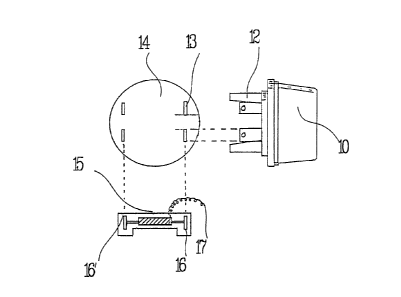Note: Descriptions are shown in the official language in which they were submitted.
~ ~ ~ 54'~
The invention relates to a voltage monitoring device,
~)articlllarly aclapted for monitoring the mains vol-taye supply at
cus-tolller premises.
r; ~lectricity utilities currently monitor mains voltac3e
at certa:in pOill-tS in the distribution system, but there is no
easy and economlcal means of monitoring mains voltage at cus-tomer
prernises. Tllis informatlon is useful to give the util:lty compa-
nies the loacl marlayement information they need to plan their dis-
i0 tril)ut~ l ancl supply systems.
~ n ol)ject of this invention is to provide a device
capai)le of economically monitoring voltage supply a-t customer
prelll:ises.
:1. 1;
According to the present invention there is provided a
voltage monitoring device, said device being adapted to fit
withirl, or be mounted externally of the housing of a standard
eLectricity meter and comprising means for repeatedly monitoring
t;tle vo:ltage of the mains supply, means for storing data derived
Lrom said measurements for consecutive predetermined periods, and
mearls for re]easing the stored d~ata upon request.
In a preferred embodiment, the data stored for each
precletermined period, which may be five minutes in duration, are
l:he hiyh, low and mean voltages. The voltage measurenlents are
preferably digitized and fed to a four-bit micro computer. The
derived data are then stored in a thirty-two kilobyte CMOS static
R~M.
The device can be provided with an RS-232 interface and
associated link for connection to a commercial personal compu-ter
uporl removal from the meter housing.
The invention will now be described in more detail, by
way of example only, with reference to the accompanying drawings,
-- 1 -- I
~ 7~i4~5
~n whlch:-
Figure 1 is a block diagram of a voltage moni-toring
device in accordance with the inven-tion; and
Figure 2 illustrates the method of monitoring the
device is moun-ted on a meter.
The voltaye monitoring device sho~n in the Figure com-
pri,es a four-bit microcomputer wi-th clock 1 associated with the
3~. kilol)yte ~MOS s-tatic R~M 2. The unit is driven by a power
.~up)ly 3 der:ived from the 3-terminal mains inpu-t conslsting oE a
neu~ra:L :line ~ and two live lines 6. The power supp:Ly 3 is also
corlrlected to a back-up capacitor 7 that is capable of providing
power over an extended period of time to prevent loss of data in
Ihe everlt of a power failure.
The three mains supply terminals 4,5,6 are connected to
a voltage sensing device 8, which in turn is connected to an ana-
:log--to-digital converter 9.
The output of the 4-bit microcomputer is connected by
via a serial link to an RS-232 interface capable of con~llunicating
wi-th a host computer, such as a standard IsM PC.
The device is designed to be installed as a retrofi-t
Ullit either within or externally of the housing of a standard
type plug-in domestic electricity meter. The device is connected
to the three main supply terminals and in operation the voltage
sensor ~ continuously monitors the voltage of each live line.
Voltage measurements are normally made 60 times per second. The
measurements are conver-ted to digital form in A to D converter 9
and -the rnicrocomputer 1 derives from the voltage measurements the
higll, low and mean voltage as well as the number of missing
pulses for each five-minute interval. There thus four readings
per five-minute interval, 48 readings per hour, 672 readings per
~ 5~
day or 20,160 readings per month. These readings are stored ln
tlle 32 kilobyte non-volatile static RAM 2. The microcomputer 1
is shown as the four-bit microcomputer, but can be an eight-blt
microcolnputer.
~ fter one rnonth has elapsed, the device can be removed
~ronl the me-ter base and returned to the central station where the'
clata is -trans~erred to a commercial PC via the RS-232 link. The
device can be equipped with a radio transmi-t-ter and receiver, or
J0 some other form of remote communications device, if desired for
establishing communication with a remote sta-tion.
While the power is normally derived from the mains sup-
ply, dala inteyri-ty is maintained by the super capacit;or 7 in -the
L5 evelll. o~ power failure.
Figure 2 shows how the voltage monitoring device can be
mourlLed on a standard meter. In Figure 2, a standard residential
k:Llowa-tt/hr meter 10 has four protruding blades 12 that fit into
corresponding slots 13 in a standard meter base 14. The voltage
monitoring device is built on a bridge type plat~orm 15 with -two
spaced slots 16, 16' designed to fit over a pair of protruding
blades 12 of the meter 10. The bridge 15 mounts -the electronic
components described with reference to Figure 1. The device can
a:Lso have a floating plug-in neutral wire 17 for connection to
the neutral line running through the meter.
The slot 16,16' is equipped with metallic contacts that
brush against the protruding meter blades to establish contact
wlth those legs and supply current to the monitoring device.
The physical construction described with reference to
Flgure 2 has the important advantage that it can be quickly and
easi:Ly slipped over an existing meter. No physical modification
of -the meter is required.
~ 4~t~i
The device, which is normally in the form of a single
solicl state l-nodule, can be easily placed inside an existing util-
i-ty me-ter, or in the alternative a meter base, by a utility staff
member. In this way, a utility can easily monitor line voltage
at cus-tomer premises in any selected area. The device can easily
be -transEerred from one customer to another when voltage monitor-
ing is no longer considered necessary. At a central the data can
be easi:ly manipulated to show underlying patterns and :Line vol-
tage variations in areas served by the utili-ty.
1()
~.()
